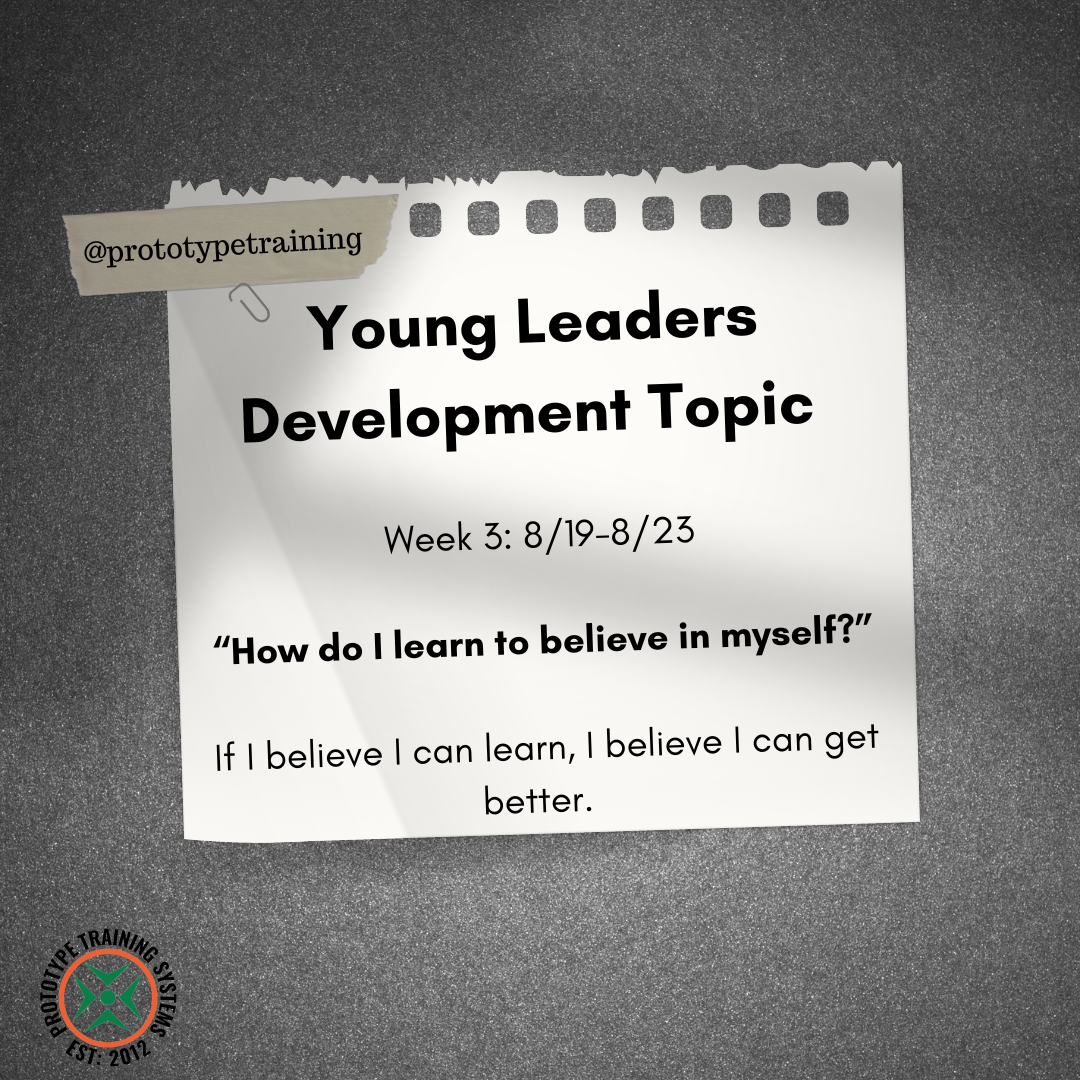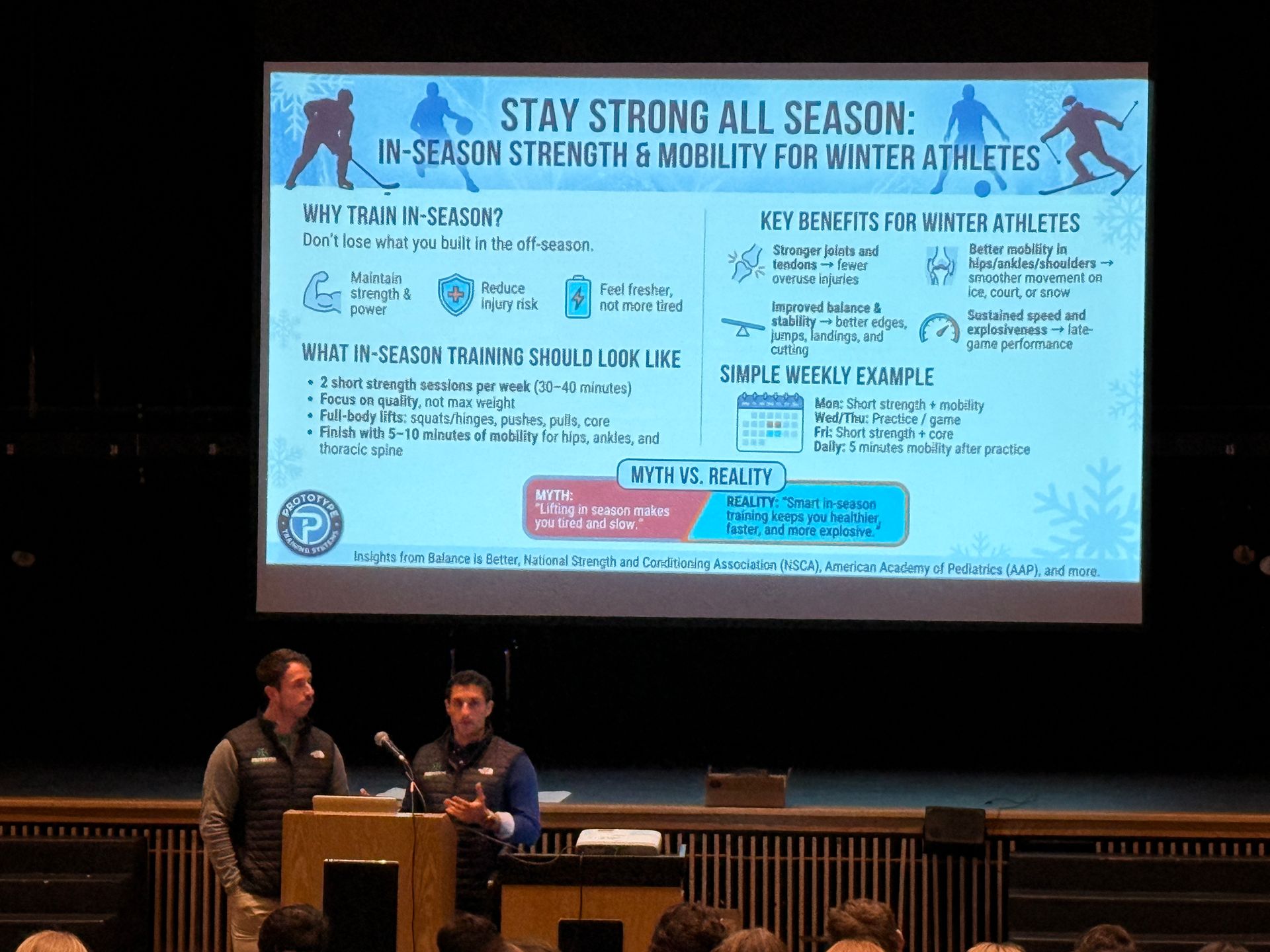Developing Young Leaders: Believing in Yourself
August 20, 2024
Developing Young Leaders: Believing in Yourself

Developing Confidence to Acheive
Our vision at Prototype is to not only help people live longer, better and more full filling lives, but to help people reach their full potential. As we continue to innovate on our approach to coaching, it's motivating to us to help not only our adult members but also our youth members/athletes become the best versions of themselves
When most people hear performance training, they think of physical training getting faster, stronger more agile, but the mental side of training is often overlooked or not considered to be an important part of youth developing youth athelets.
We see an ever growing need to help our youth members. The world is moving faster than ever, more information and false information at the tip of our fingers, studies showing kids have less meaningful relationships and social connections now more than ever, more kids suffering from mental health challenges (anxiety, depression, etc), physical activity has become less of a priority in schools, kids staring at a screen longer and more than ever before.
This is a hard problem and why we have started to implement weekly lessons on the mental side with our youth athletes. The main focus will remain building stronger athletes but through the physical training, we will be incorporating lessons to build better/stronger kids/people. This will be the first email I will be sending you to update you on what we have been working on in our youth programs.
This week's topic is Expectations vs Reality, many times we have had certain expectations going into a challenge or problem. This week we asked the kids for some examples when their expectations didn't meet reality.
Some of the examples the kids have brought up were
- "Going into games and thinking your team is way better no way we can lose."
- "Or the opposite thinking there is no chance we win this game the other team is so good."
- "Thinking you know the material going into a test, so do not study as hard and then to realize you didn't know as much as you thought and get a bad grade"
These are all good examples of when your expectations don't actually meet the reality of the challenge. What we discussed is first building better awareness if a challenge is “Hard mode” or “Normal mode”
Easy Mode:
- Could do it in my sleep
Normal Mode:
- Something I do regularly in my everyday life
Hard Mode:
- I need to prepare (use my training) and think creatively
We really like this framework, you can think selecting a difficulty mode in a video game, something the kids relate to. It helps you accept and acknowledge the challenge or problem you face. If you approach a Hard mode problem thinking you are playing in Normal mode a lot can go wrong. This is where have better awareness on where your expectation meet reality can payoff.
If we approach a Hard mode challenge thinking it will be normal we won’t be prepared and can be caught off guard and this can shut us down or cause us to be less creative in our approach, thinking we can just do what we have done in the past and it will work out just fine. The opposite can be the case if we approach everything like its Hard mode when in reality its Normal mode it can cause us to waste a lot of energy when all we need to do is take some action and get into it.
We will continue to update you on the lessons we are sharing with our youth athletes weekly. In the meantime Im curious on your thoughts?
Previous Blogs

Devon is a fantastic part of our community — always kind, coachable, easy-going, and consistently putting in the work. She shows up, supports others, and truly represents what PTS is all about. Prototype of the Month is well deserved! Below, she answers a few questions about her time at PTS. 1.) Share your experience at Prototype After what felt like an entire year of sitting during grad school, I knew I wanted to be more active. I came back to Prototype, and it was the best decision. I’ve made so many new friends here who make every class fun (no matter how tough the workout is) but my favorite moment has to be meeting my boyfriend Ed! 2.) What is your favorite part about being at Prototype? I used to do at-home workouts and always felt like something was missing. When I came to Prototype, it felt like I finally found that missing piece, the community! It truly makes a huge impact. Everyone here genuinely wants the best for you. 3.) What are your hobbies and activities? If I’m outside, I love playing pickleball, skiing, and going for walks. And if I'm inside I enjoy crocheting, reading, or baking! 4.) How has Prototype helped you or solved a problem for you? Prototype has shown me that if you put your mind to something, you can truly do hard things. I also know I will always feel better after going to the gym. Sometimes the hardest part is just getting in the car, but I never regret it once I’m there. 5.) What are you continuing fitness goals to this point? To get some form of movement everyday and to one day get a pull up. 6.) Favorite Quote “Laughter is timeless, imagination has no age, dreams are forever.” -Walt Disney

Tim has been an incredible part of our community — always positive, funny, generous, and willing to help. His energy makes everyone around him better. Prototype of the Month is well deserved! Below he answers some questions about his time at PTS. 1.) Share your experience at Prototype This actually isn’t my first stint at Prototype - I’ve been around and worked out here a few times in my heyday. My very first legitimate class though, as a member, was 5am earlier this year and I was welcomed first by Nicole. You can all imagine how that interaction went… and I came back! Prototype is welcoming, fun, clean, and I’ve made amazing friends along the way. It is one of the best hours of my day. 2.) What is your favorite part about being at Prototype? Prototype is not just another workout but a mental reset for me, it fills my cup. 3.) What are your hobbies and activities? Activities mostly involve time with my family outside whenever we can, trips to Ptown and traveling all over for work. I have a hard time sitting still and typically keep a busy schedule. Mix in photography and interior design opportunities with fitness and family and I’d say that's my perfect mix. 4.) How has Prototype helped you or solved a problem for you? I work remotely so in person face to face conversation is something I’ve found I need for my mental health. I’m also super competitive so I tend to push a little harder when I workout with others. 5.) What are you continuing fitness goals to this point? I want to be a parent who can show up for their kids in every aspect of life, which also means physically. Staying fit is important to be able to keep up with them as we collectively get older. I am training for a few Hyrox races coming up but mostly just trying to maintain my current level of fitness for as long as possible. 6.) Favorite Quote “There is only one success - to be able to live your life in your own way” -Fortune Cookie
Climb to New Heights
Prototype Training Systems is more than a gym - it is a lifestyle. Join us today!


